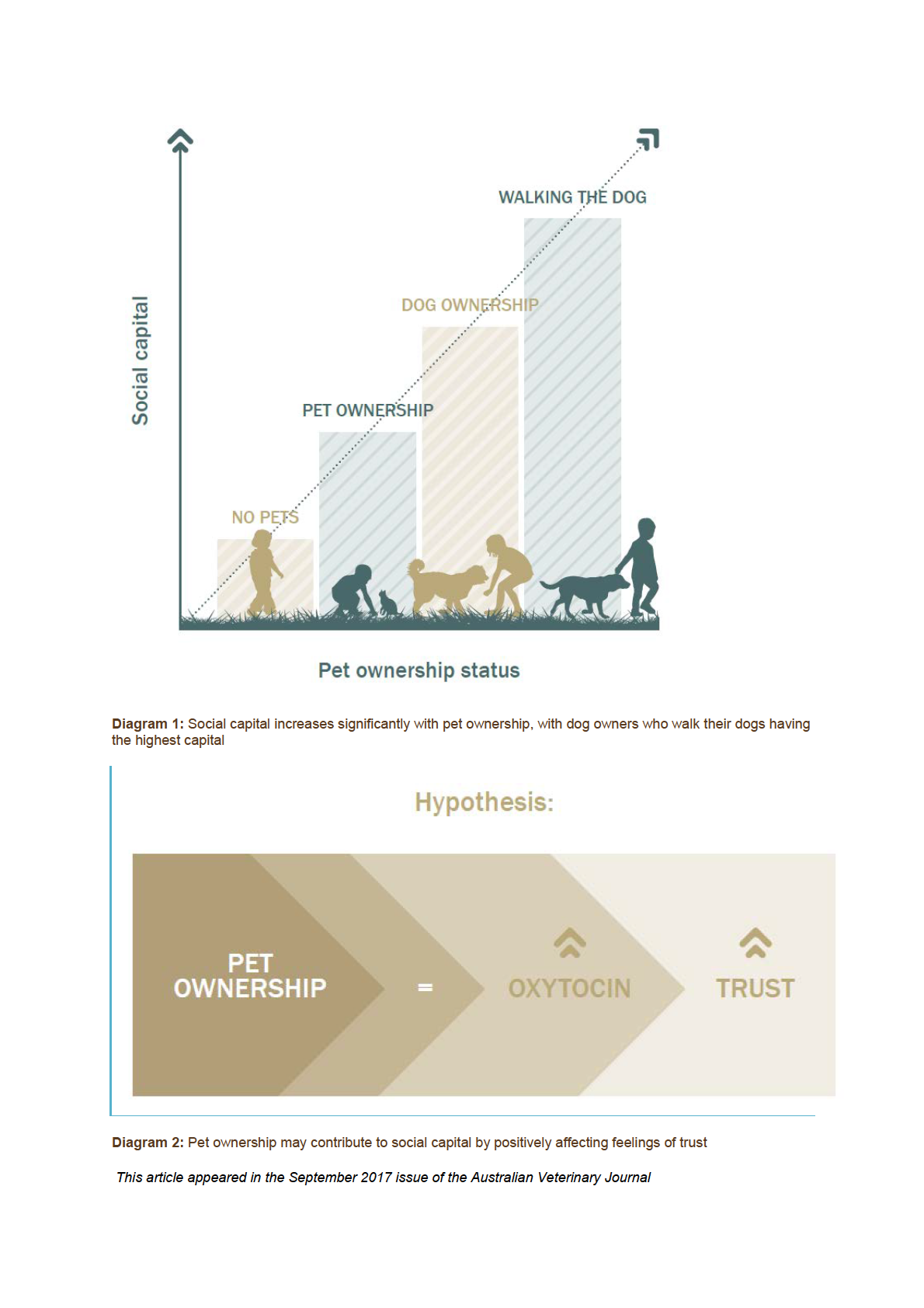2
robert.chipman Digitally signed by robertchipman
Date: 2018 07 16 18:21:28 +10'00'
BRIEF FOR CAF (THROUGH DCAF):
MEMORANDUM OF UNDERSTANDING WITH YOUNG DIGGERS’ DOG SQUAD –
ARRANGEMENT OF TIME FOR SIGNATURE
Branch: DGCHAP-AF
Reference: B1971473
Due Date: Discretionary
Recommendations:
That you:
(a)
Note your earlier agreement for commencement of a six-month trial of the RAAF
Workplace Welfare Dog Program across Air Force under the sponsorship of the Air
Force Chaplain Branch.
(b)
Note the preparedness of the executive management of the Young Diggers’ Dog
Squad to co-sign a Memorandum of Understanding with Air Force to establish the
RAAF Workplace Welfare Dog Program.
(c)
Note the change in scope of locations for placement of dogs with Chaplain handlers at
Air Force Bases.
(d)
Agree to the change in scope for locations for placement of dogs with approved
Chaplain handlers.
(e)
Agree to a date and time for co-signing of the Memorandum of Understanding with
an authorised representative of the Young Diggers Dog Squad in your office.
Background
1.
Enclosure 1 is the original brief proposing a six month trial of the RAAF Workplace
Welfare Dog (WWD) Program that you approved in Dec 17, with dogs to be trained by the
Young Diggers’ Dog Squad (YDDS) and placed at three Air Force establishments,
Edinburgh, Williamtown and the Canberra area.
2.
Enclosure 2 is the Memorandum of Understanding (MOU), now ready for signing
between Air Force and YDDS to set the terms and conditions for conduct of the six-month
trial of the RAAF WWD Program.
Key issues
3.
Since approval, progress has been impeded by the requirement for a Memorandum of
Understanding (MOU) between Air Force and YDDS to legally constitute terms and
conditions of the program. Development of the MOU was prepared in consultation with
SOLS-AFHQ staff and referred to the executive management for consideration and
agreement.
3
4.
As a result of the s47F
s47F
, and the consequent ‘changing of the guard’, the MOU stalled. The MOU, with all
its terms and conditions, was agreed to at a meeting of the YDDS Directors on Wednesday,
27 Jun 18.
5.
Under the original proposal, Chaplains at Edinburgh, Williamtown and the Canberra
area volunteered to participate as handlers in the program. Due to the elapsed time since
approval of enclosure 1, circumstances have changed for two of the three Chaplains who are
unable to continue. As the Program is dependent upon voluntary participation of Chaplain
handlers, the invitation for participation was widened and the Bases that will now be involved
are Williamtown, East Sale and Pearce.
Consultation
6.
SOLS-AFHQ has concurred with the context of the MOU and the executive
management of YDDS is now prepared to co-sign the MOU. COs and SADFOs at RAAF
Bases Williamtown, East Sale and Pearce have been consulted and have indicated their
favour with the conduct of the trial program over a six-month period.
Conclusion
7.
Your agreement is now sought to set a date and time for s47F
, a Director
of YDDS authorised to represent the organisation, to attend your office for co-signing of the
MOU. In addition, your agreement is sought for a change of scope to now include RAAF
Bases East Sale and Pearce in lieu of Edinburgh and the Canberra area, along with RAAF
Base Williamtown. DSIM-AF has also requested that a Ministerial Advice be prepared to
inform MINDEF and MINDP of this initiative.
(a) Noted / Please Discuss
(b) Noted / Please Discuss
Digitally signed
(c) Noted / Please Discuss
mark.will by mark.willis
(d) Agreed / Disagreed
Date: 2018.07.13
(e) Agreed / Disagreed
is
13:07:04 +10'00'
s22
Digitally signed by
gavin.davies
MA Willis
Date: 2018.07.18
CHAP (AIRCDRE)
17:23:13 +10'00'
DGCHAP-AF
GN DAVIES, AO, CSC
Tel: ( 02) 6265 7013
AIRMSHL
M: s22
CAF
Jul 18
Jul 18
Branch/Section Head
DGCHAP-AF
W: (02) 6128 7595
Mob: s22
Action Officer
WGCDR PL Cranage
W: (02) 6128 7572
Mob: s22
Enclosures:
1.
Approved Brief to CAF for trial of RAAF Workplace Welfare Dog Program.
2.
MOU – RAAF Workplace Welfare Dog Program.
BRIEF FOR CAF (THROUGH ACAUST AND DCAF): TRIAL OF A RAAF
WORKPLACE WELFARE DOG PROGRAM
Branch:
DGCHAP-AF
Reference: R32057907
Due Date: EOY 2017
RECOMMENDATIONS
That you:
(a)
Note the beneficial effects that Workplace Welfare Dogs (WWDs) can have on the general welfare
and morale of individuals and Unit personnel.
(b)
Agree the attached Initial Business Case proposing
a trial placement for the WWD Program at
RAAF Bases Edinburgh and Williamtown and the Canberra area.
BACKGROUND 1.
In May 2015, s47F
(PERSPOL1), then a member of the charitable
organisation ‘Young Diggers Dog Squad’ (YDDS), presented a brief to the Air Force Chaplaincy
Leadership Group on YDDS’s proposition to train and provide Welfare Dog services to Air Force.
Throughout the presentation s47F
was accompanied by her own Welfare Dog, Tana,
a former ADF explosives detection dog.
2.
Air Force Chaplain Branch sponsorship of an initiative to place WWDs in RAAF
workplaces to bolster general morale and welfare at RAAF Bases through a Base Welfare Dog
Program was advocated, subject to your approval. If approved, a six month trial could commence
at RAAF Bases Edinburgh and Williamtown and the Canberra area as soon as possible after
obtaining your agreement.
3.
This program trial will be used to determine viability and, if successful, will shape a formal
Business Case for approval of wider implementation of the WWD Program.
KEY POINTS 4.
Air Force has an opportunity to implement an innovative mental health and welfare
programme. Army and Joint Health Command have also expressed strong interest in the program.
5.
All dogs used for the workplace welfare dog program are certified assistance dogs IAW
extant Commonwealth and State legislation.
6.
The dogs used for the RAAF Edinburgh and Canberra area trials will be provided by YDDS.
The dog used in the RAAF Williamtown trial will either be provided by YDDS or will be a young
dog already owned by a Chaplain at Williamtown that, if assessed as suitable, will be trained to the
appropriate standard by YDDS for use at that Base.
7.
The attached Initial Business Case outlines details of research undertaken and procedures to
be adopted if approval is granted.
2
8.
s47D
s47G
s47G
by YDDS s47G
s47D
CONSULTATION 9.
Base Chaplains have been consulted to register interest for trial locations. SADFOs at
Amberley, Williamtown and Edinburgh were initially approached and agreed to trialling of the
program. DACAUST subsequently concurred, subject to CAF approval. SADFOs in those
regions were generally agreeable provided that the dog accesses the domestic areas only and
security staff are made aware of the dog’s presence in advance. At present, Chaplains at RAAF
Bases Edinburgh and Williamtown and more recently the Canberra area have expressed interest
in domicile of dogs, therefore, the trial will be limited to those regions for the time being.
10.
As the Canberra area Chaplain has only recently indicated willingness to participate,
SADFOs for establishments in Canberra where there is a RAAF population have also been
consulted and have indicated their support. Mr Bruno Blasi, the APS Base Support Manager
for the Russell, Campbell Park and APW precincts was also consulted due to the significant
level of APS personnel in close proximity to Air Force personnel. He has also indicated
support for the program.
11.
YDDS s47G
12.
Appropriate stakeholders have been approached for concurrence and their support is
addressed in the Executive Summary.
TIMELINE
13.
Approval by EOY 2017 would greatly assist to facilitate early consultation with
stakeholders and lead to implementation of the program in early 2018.
(a) Noted / Please Discuss
(b) Agreed / Not Agreed
K RUSSELL
GN DAVIES, AO, CSC
CHAP (AIRCDRE)
AIRMSHL
DGCHAP-AF
CAF
Tel: ( 02) 6265 7013
M: s22
Nov 17
Nov 17
Branch/Section Head
DGCHAP-AF
W: (02) 6265 7013
Mob:
s22
Action Officer
WGCDR PL Cranage
W: (02) 6128 7659
Mob:
s22
3
Attachments:
1.
Initial Business Case.
2.
Young Diggers Dog Squad Training Manual.
3.
Australian Veterinary Association article – Pets prove to be a positive influence on social
capital
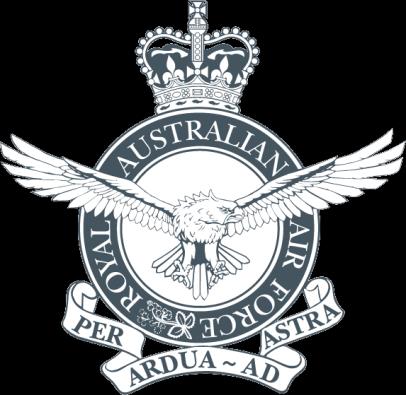
INITIAL BUSINESS CASE
ROYAL AUSTRALIAN AIR FORCE WORKPLACE WELFARE DOG PROGRAM
Director General Chaplaincy – Air Force
TABLE OF CONTENTS
1.
Executive Summary.
2.
Introduction:
Business Needs.
Project Background.
The Young Diggers Program.
Program Scope.
Program Plan.
Key Program Stakeholders.
3.
Program Resource Requirements:
Proposed Statement of Requirements.
Identification of suitable handlers.
4.
Risk Management:
External Risks:
- Training Program.
- Dog selection.
- Accreditation of YDDS.
Internal Risks:
- Awareness of program.
- Lack of potential handlers.
- Funding issues.
- Mistreatment of the dog.
- Dog aggressiveness and toilet training.
- Health issues.
5.
Safety Considerations.
6.
Cost.
7.
Benefits to Air Force.
8.
Recommendation.
EXECUTIVE SUMMARY
1.
This Initial Business Case seeks approval from CAF for a six month trial of a RAAF
Workplace Welfare Dog (WWD) Program at RAAF Bases Edinburgh and Williamtown and in the
Canberra area. Should the program prove successful at the conclusion of the six month trial, a
formal Business Case will be submitted seeking approval for wider establishment of the program at
viable establishments.
2.
The program will be sponsored by DGCHAP-AF in concert with the ‘Young Diggers Dog
Squad’ (YDDS) from whom the dogs will be sourced s47D
The dogs,
usually rescued dogs, and their select Chaplain handlers, will undergo training to Level 4
certification with YDDS accredited trainers initially for two weeks at the Bathurst Correctional
Facility and thereafter in their local areas for supplementary training to befit them for the task.
3.
The implementation of the RAAF WWD Program will be of great benefit under the
sponsorship of RAAF Chaplaincy. This initiative is viewed as an appropriate and natural extension
of RAAF Chaplaincy, as the aim of the program is to exponentially raise morale and general
awareness of mental health as one of the keys to the overall health and wellbeing of the
organisation. These dogs have the potential to extend the mission of RAAF Chaplaincy further and
to reach out to many more members who may be suffering emotionally or psychologically in
isolation.
4.
The intent is for the dogs to be home-kennelled indoors in a family setting with a YDDS-
approved Chaplain handler who will visit access-approved workplaces in company with the dog to
foster pastoral relations, encourage conversation and enhance morale. At the conclusion of each
working day the dog will return to the home of its Chaplain handler.
5.
There will be no commingling of WWDs or Military Working Dogs (MWDs) at any of the
regions and the dogs will sport a distinctive vest denoting that they are a WWD. The acting Brand
Manager is amenable to the use of the RAAF emblem on a GPU-patterned vest with the words
‘RAAF Welfare Workplace Dog’ emblazoned. CO RAAFSFS is also supportive provided that
there is a clear distinction between MWD and WWD vests.
6.
The Bases originally selected for the trial were Amberley, Williamtown and Edinburgh and
the SADFOs at these bases are supportive of the trials subject to the dogs not venturing into areas
with elemental WHS requirements, nor causing disruption to working routine. SADFOs for
Canberra-based Units and the Base Support Manager for the Russell, Campbell Park and APW
precincts in the Estate & Infrastructure Group are also supportive. DACAUST has also endorsed
the trial subject to ACAUST concurrence and CAF approval; however, only Chaplains at
Williamtown, Edinburgh and Canberra have been identified for participation to ascertain feasibility,
therefore, the trial would be restricted to these three regions.
7.
The Chaplain handlers are mindful that acceptance of a dog will be a commitment for the
life of the dog irrespective of the outcome of the trial and that the dog remains a dedicated
functionary during the Chaplain’s tenure at the Base, and possibly beyond, at successive locations.
YDDS s47G
.
8.
Performance measures will be applied to test the effectiveness of the WWD Program
throughout the trial. The effectiveness of the Chaplains’ visits in relation to social engagement and
2
interaction with members at the visit sites would be estimated, drawing on feedback from members
to Chaplains and Unit management.
9.
Other performance measures might include observation of the influence the WWDs have on
visitors to the Chaplaincy Centres based on the visitor comfort levels in the presence of the dog.
This feedback on effectiveness would be compiled by Chaplains in a monthly report to unit
management at the relevant bases. At the conclusion of the trial period a consolidated report would
be provided to CAF, optimally in a formal Business Case seeking affirmation of the Program.
10.
DGPERS-AF, DAFH, CCJHC and SOL-AFHQ have been consulted and concur with the
proposal. From a health perspective, DAFH and CCJHC are content to support the program
provided that it focuses on strategic health and wellbeing rather than PTSD and that the dogs are
referred to as ‘Workplace Welfare Dogs’ rather than ‘Assistance Dogs’ to distinguish them from
dogs with higher levels of specific function. SOL-AFHQ advised that a MOU between YYDS and
Air Force would be appropriate and that assistance could be provided for its drafting and execution.
INTRODUCTION
1.
Business Needs. The value of assistance dogs in promoting wellbeing for individuals and
social interaction within groups has long been understood. This innovative capability tool affords
Chaplaincy a unique opportunity to contribute to the mental health and wellbeing of Air Force
personnel.
2.
From a capability perspective, the application of WWDs by Chaplains would enhance their
potential to reach out to struggling members who might not be inclined to seek support from a
Chaplain. This lack of inclination can be due to differing personal religious beliefs, the stigma
perceived to be associated with seeking personal support, or simply a reluctance to address
internalised issues. A WWD would serve as an ‘ice-breaker’ to establish a point of connection and
potentially, a bond between the Chaplain and members, although handlers would first need to
establish comfort levels of individuals with the presence of a dog prior to its introduction to a
workplace.
3.
Chaplains are able to go where psychologists do not, by reaching out to personnel in the
field and consequently, a WWD would work as an enabler to the mission of the Chaplain, thereby
engendering a greater positive effect on members.
4.
Project Background. During the May 2015 Chaplains’ Leadership Group, SQNLDR
s47F
presented a brief to senior Air Force Chaplains on the charity organisation, Young
Diggers and their ‘Dog Squad’. The Young Diggers Dog Squad (YDDS) trains rescued dogs to
become assistance dogs in support of the rehabilitation of serving and ex-serving ADF members
who are dealing with PTSD and other mentally debilitating conditions. Throughout her
presentation, SQNLDR s47F
was accompanied by her own welfare dog, Tana, a former ADF
explosives detection dog.
5.
SQNLDR s47F
discussed the positive aspects of welfare dogs in RAAF workplaces as
well as RAAF Chaplaincy extending mental health support at RAAF Bases through a ‘Workplace
Welfare Dog Program’. RAAF Chaplaincy expressed keen interest in the concept and DGCHAP-
AF accepted Branch sponsorship of the initiative subject to approval from CAF.
6
.
The Young Diggers Program. Young Diggers is a reputable not-for-profit charitable
organisation that provides a variety of support services and programs to help serving and ex-serving
personnel of the ADF, their dependants and direct family members. Their main objective is to
assist personnel to enhance and maintain their quality of life during transition from military to
civilian life and help them to overcome difficulties that they may be facing.
7.
The YDDS also trains rescued dogs to become role-specific Assistance Dogs in the main to
support the rehabilitation of our serving and ex-serving ADF members who are dealing with PTSD.
In addition to helping members and their families, the program also saves the lives of abandoned
dogs. The dogs can also be trained in a non role-specific function to interact with groups of people.
YDDS identifies suitable candidate dogs and provides specialised training and certification for both
the dogs and their handler.
8.
The YDDS is a registered dog training organisation run entirely by the volunteers at Young
Diggers and groups and businesses assist with sponsorship for the dogs to enable continuity of the
program. s47G
they are trained through four levels of
certification to meet the Public Access Test (PAT) standard required under local, State and Federal
laws before handover.
2
The four levels are defined as follows:
a.
Level 1 assessment. Conferment of the basic obedience certificate that demonstrates the
handler has sound control of their canine.
b.
Level 2 assessment. The dog has earned the Young Diggers Learner’s jacket and an
accreditation ID. The team is then allowed access to public passage such as movie theatres,
restaurants, shopping complexes and supermarkets.
c.
Level 3 assessment. This is a nationally-recognised assessment test in preparation for the
PAT.
d.
Level 4 assessment. Recognises successful completion of the PAT and provides the dog
with full accreditation for access to public passage including all forms of public transport.
9.
The copy of the YDDS s47G
at attachment 1 provides greater detail of dog
training, handler obligations, assessment levels and local, State and Federal legislation governing
access to public passage.
10.
Program scope. The scope of the RAAF WWD Program is to trial specially trained dogs as
Welfare dogs for RAAF Chaplaincy at two RAAF Bases, Williamtown and Edinburgh, and in
Canberra for six months initially, with a view to seeking formal adoption of the program at RAAF
Bases Australia-wide if the trial proves successful.
11.
The scope does not include a trial of welfare dogs for individual members undergoing
mental health treatment in the RAAF. The intent of this project is to prove the mateship value of the
dogs working with Chaplains to build morale and enhance the emotional health and wellbeing of
Air Force members and associated individuals.
12.
Program Plan. The implementation of RAAF WWDs is likely to be carried out in three
phases. Phase 1 would be the six month-long trials at RAAF Bases Edinburgh and Williamtown and
across Canberra. Phase 2 would be the RAAF-wide invitation of other Chaplaincy centres and
SADFOs to join in the program. Finally, Phase 3 would be the mature state of the program,
involving continuous maintenance and improvement. The second and third iterations of the project
would be refined and further scoped following a successful outcome of the Phase 1 trials.
13.
Key Program Stakeholders. The major stakeholders in the program are:
a.
CAF.
b.
HPC.
c.
DGPERS-AF.
d.
DGCHAP-AF.
e.
JHC.
f.
ACAUST.
g.
Base SADFO/ABXOs.
h.
Base Chaplains.
i.
SOL-AFHQ.
j.
YDDS.
3
PROGRAM RESOURCE REQUIREMENTS 14.
Despite the wide implications of the RAAF WWD Program, the program should not cause
significant impost on existing RAAF resources. The dogs would be housed and taken care of by
volunteer-handler RAAF Chaplains s47G
from YDDS supplementation for the
duration of the do’s role as a WWD. During the dog’s non-working hours, it would essentially be a
pet of the handler and their family. The only resources required would be:
a.
Initial dog and handler training for two weeks proximate to the s47B(a)
s47B(a) . s47G
s47D
b.
c.
YDDS s47G
provided by YDDS.
15.
Proposed Statement of Requirements. The requirements that are viewed as integral for
the success of the program include:
a.
Agreement for participation of Chaplains as WWD handlers in trial locations with Air Force
populations.
b.
s47G
with YDDS.
c.
Inclusion of an additional task for SODGCHAP-AF to act as the RAAF WWD Program
Manager within the Air Force Chaplain Branch.
d.
SOL-AFHQ legal support to draft the MOU between RAAF and YDDS.
e.
Public Affairs Office support for official launch of the program.
16.
Identification of suitable handlers. YDDS s47G
of Chaplains for
participation in the program. Sponsorship of the program is vested in the Chaplain Branch because
Chaplains will have already completed training in the following skill sets:
a.
Applied Suicide Intervention Skills Training.
b.
Two Day Mental Health First Aid Course.
c.
Senior First Aid Course with annual CPR refresher training.
d.
Difficult Conversations.
e.
Listening Skills.
4
17.
These skill sets are vital and will assist the Chaplains to identify personnel who may benefit
from further pastoral interaction.
RISK MANAGEMENT
18.
In considering risk management for this program, a number of points were addressed when
consulting with stakeholders. They concern external and internal risks as follows:
a.
External risks. Potential risks considered were:
(1)
Training program. Training will be undertaken by YDDS, which is a registered dog-
training organisation. The dogs will be trained to Level 4 certification by s47B(a)
s47B(a)
Chaplain handlers will then be required to undertake a
two week induction handover training course in Bathurst and ongoing annual
supplementary training will be provided to the handlers in area.
(2) YDDS s47G
(3) An MOU is to be drawn up in accordance with Air Force Chaplaincy’s requirements and
YDDS to mitigate external legal risk factors and combat any possible ambiguity and
misunderstanding. The mutually agreed MOU will also include any associated fees and
charges.
(4) The dogs will all be trained to Level 4 certification with accreditation under State and
Federal laws. YDDS s47G
The dogs will
accompany their Chaplain handlers on postings and agreement to this Business Case will
ensure continuity of the program in successive locations.
(5)
Dog selection. YDDS s47G
. Ideally, suitable
dog candidates would be medium-sized and optimally aged between six months to two
years old for the most effective training.
(6)
Accreditation of YDDS. YDDS is an established not-for-profit charity for both current
and former members of the ADF. This is a reputable charity which was previously the
s47G
b.
Internal risks. Potential risks considered were:
(1)
Awareness of the program. A launch of the new WWD program through an
appropriate Public Relations campaign is recommended to mitigate the risk that the aim
of the program will be misunderstood. The campaign would clearly inform personnel of
the roll-out of the program, and its objectives and benefits to ADF personnel.
5
(2) The Defence Community Organisation (DCO) is very supportive of this unique program
and will also be a valuable source of networking about the aims of the program within
the wider Defence community.
(3)
Lack of potential handlers. The scope of the trial has been limited to three handlers to
gauge the likely success of the program. It is anticipated that the program will expand
once other Chaplains observe the benefits to be gained from pastoral visits with a
companion dog.
(4)
Funding issues. s47D
s47G
YDDS. s47G
YDDS-
s47G
s47G s47D
(5)
Mistreatment of the dog. YDDS s47G
YDDS s47G
. The
Chaplain would remain the responsible person for the correct treatment of the dog while
on duty.
(6)
Dog aggressiveness and toilet training. YDDS
s47G
. Breeds such as Labradors are well-known for
their gentle nature and temperament. A Welfare dog will undergo puppy obedience
training to correct any inappropriate behaviour such as biting during play and going to
the toilet anywhere in the house. Dogs that have not been de-sexed can retain any natural
aggressive tendencies which could result in biting. To prevent this, dogs must be de-
sexed as well as being appropriately trained, including toilet training at an early age so
as not to bite humans, irrespective of the dog’s breed. This will greatly ensure that at the
right age, the dog will be suitable for training as a Welfare dog.
(7)
Health issues. YDDS s47G
s47D
Such coverage is recommended as the ultimate
defence for a dog falling sick or getting injured. This insurance can cover unforeseen
events such as major surgery and dental work. There is always the vulnerability for an
active dog to fall ill; however, with proper regular veterinary care the likelihood of
significant cost from aggravated illness or injury could be greatly minimised.
6
SAFETY CONSIDERATIONS 19.
Chaplains who will be designated handlers will liaise with RAAFSAFE advisors to conduct
risk assessments in their respective areas. An appropriate area of the Chaplaincy centre will be
allocated for the dog during non-working business hours. Chaplains will be mindful of potentially
allergic and fearful members in workplaces and Units will be consulted prior to a Chaplain and
WWDs entering the facility during the trial phase.
COST
20.
s47D
s47G
YDDS. s47D
BENEFITS TO AIR FORCE
21.
Leading Australian and international psychologists and mental health workers agree that
animals can directly benefit the mental and physical health of people1 as discussed in attachment 3.
Benefits include improvement to cardiovascular health, reduction of overall stress and anxiety
levels, decreased loneliness and depression, promotion of social cohesion, and can assist those
affected by a number of mental illnesses. Through the medium of a companion dog as an ‘ice-
breaker’ Chaplains will be best placed to identify those individuals that may be in need of
intervention. The minimal costs to Air Force for supplementation and care of WWDs would be
outweighed by the advantages to be derived from integration of the RAAF Workplace Welfare
Dogs.
RECOMMENDATION
22.
In the view of foregoing considerations and clear benefits to Air Force personnel, trial of the
______________________
1 Australian Veterinary Association article – Pets prove to be a positive influence on social capital
7
program for a period of six months is strongly recommended.
K RUSSELL
CHAP (AIRCDRE)
DGCHAP-AF
R8-3-042
Tel: (02) 6265 7013
Mob:s22
email: xxxxx.xxxxxxx@xxxxxxx.xxx.a
Nov 17
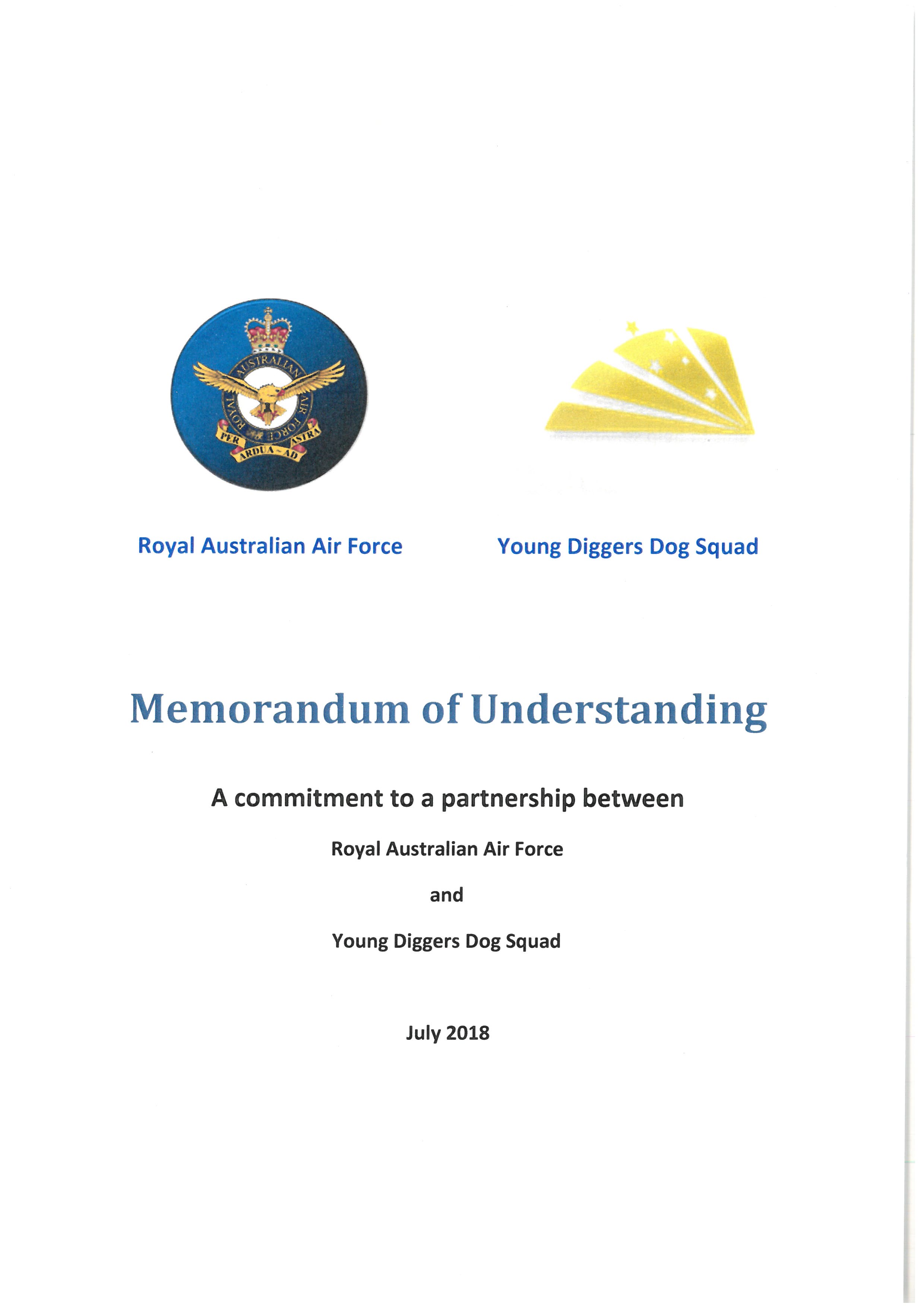
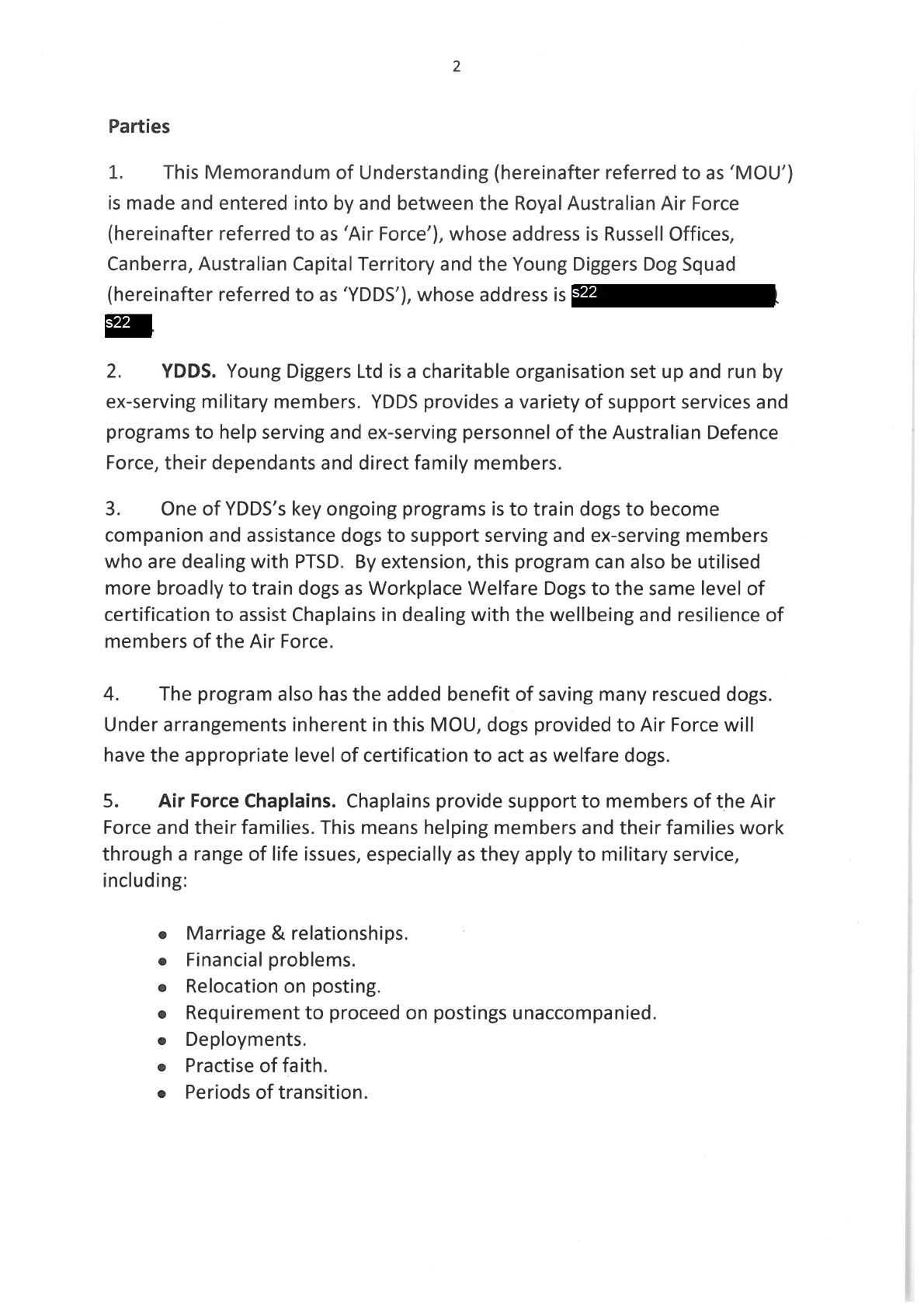
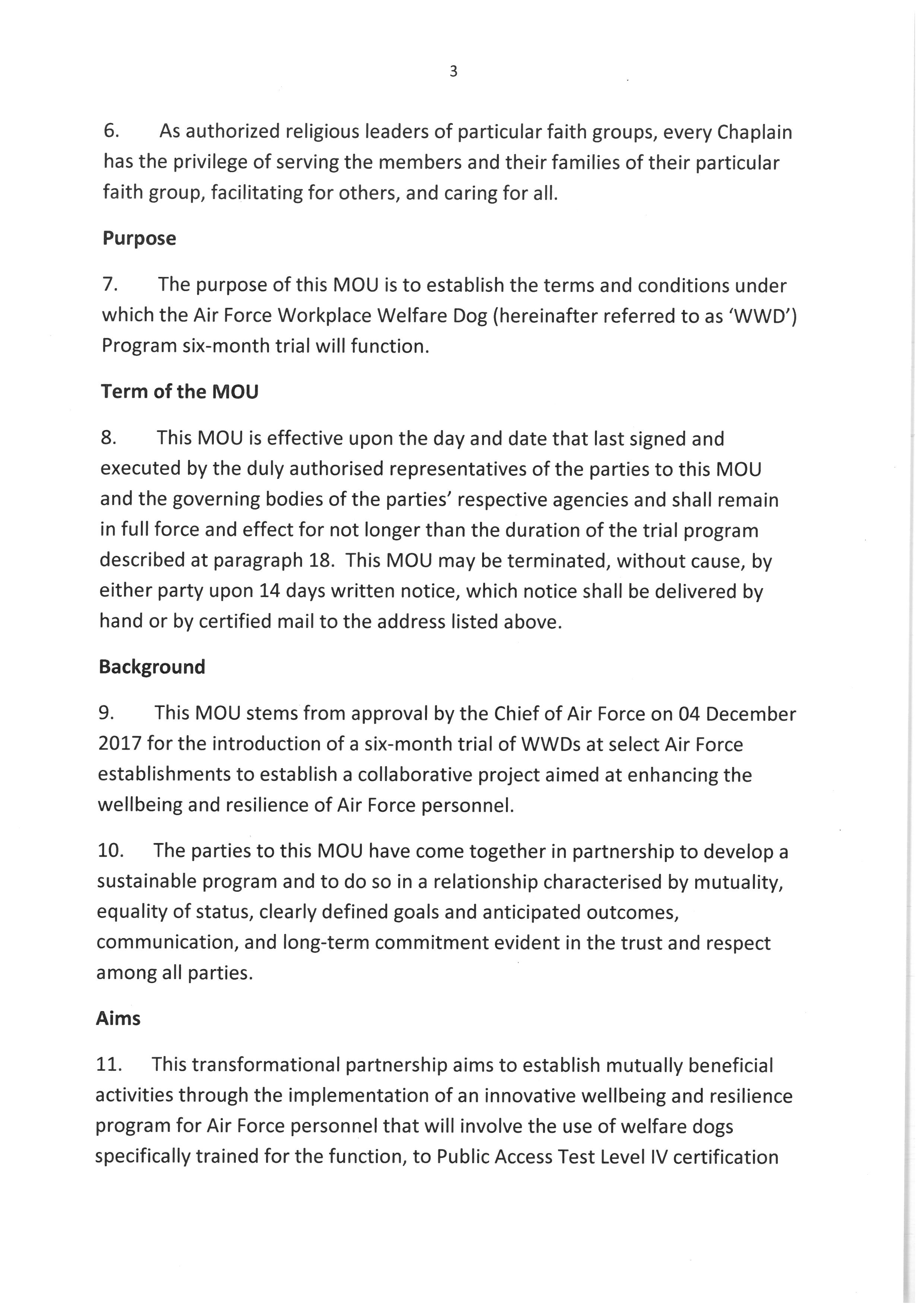
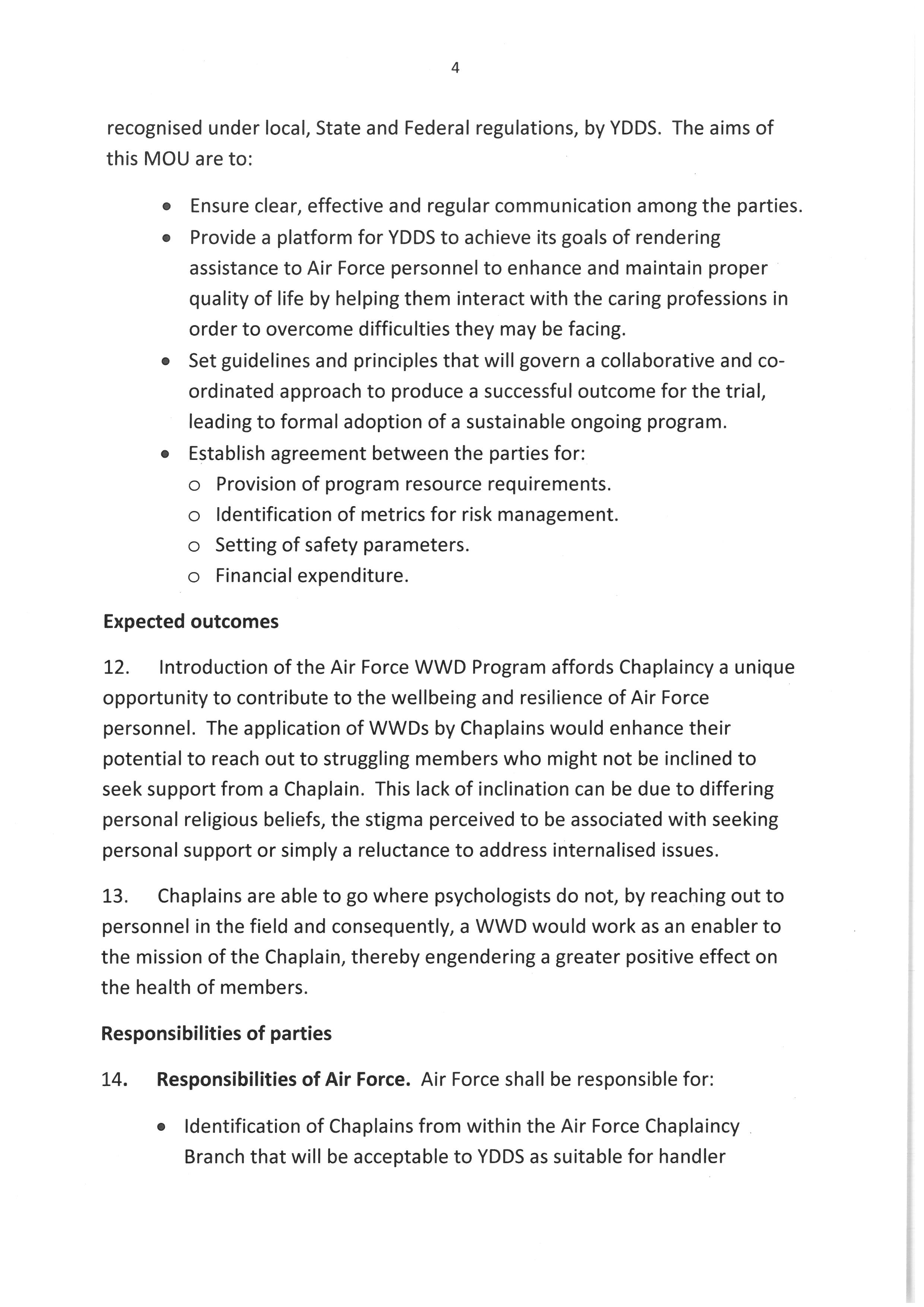
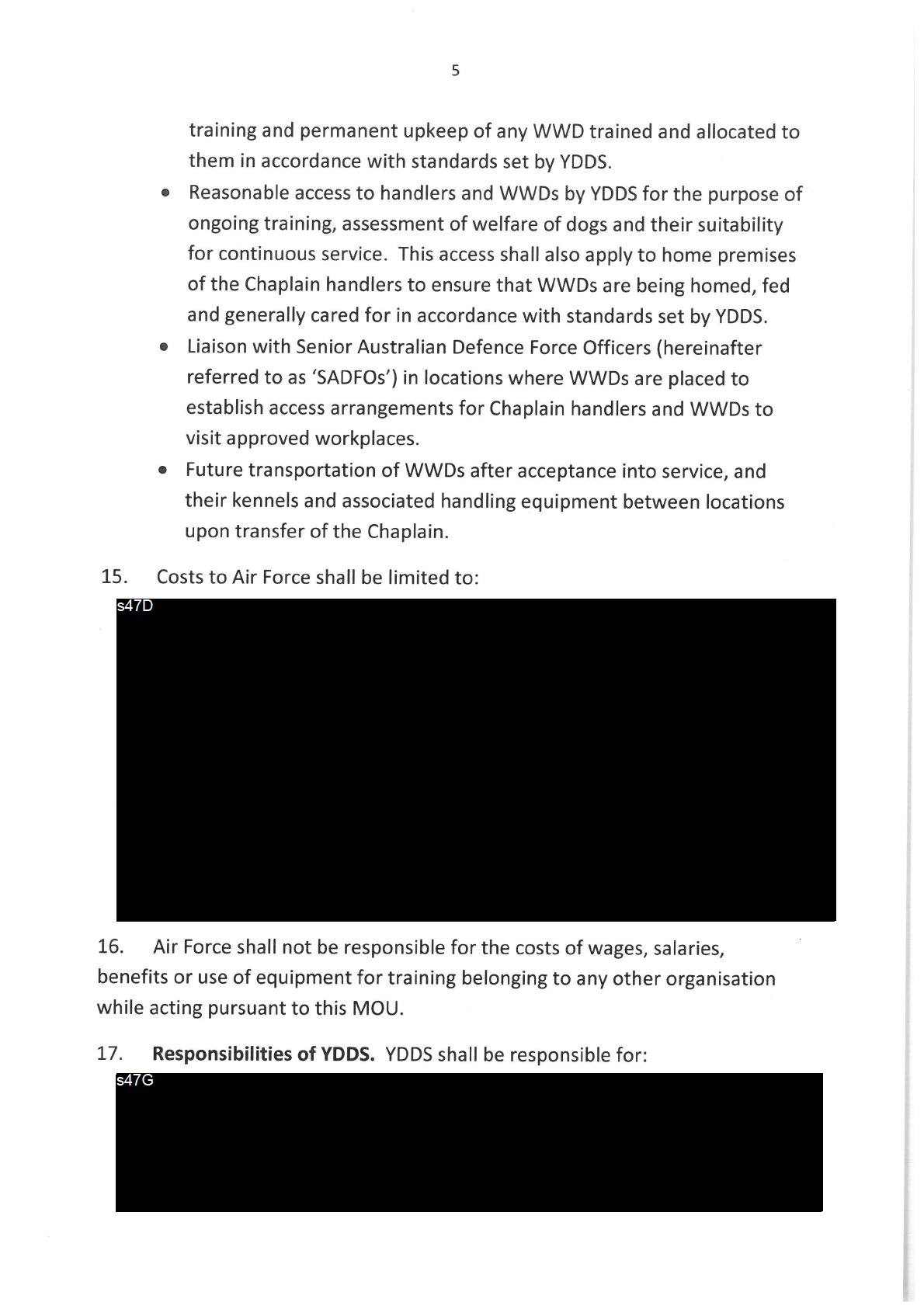
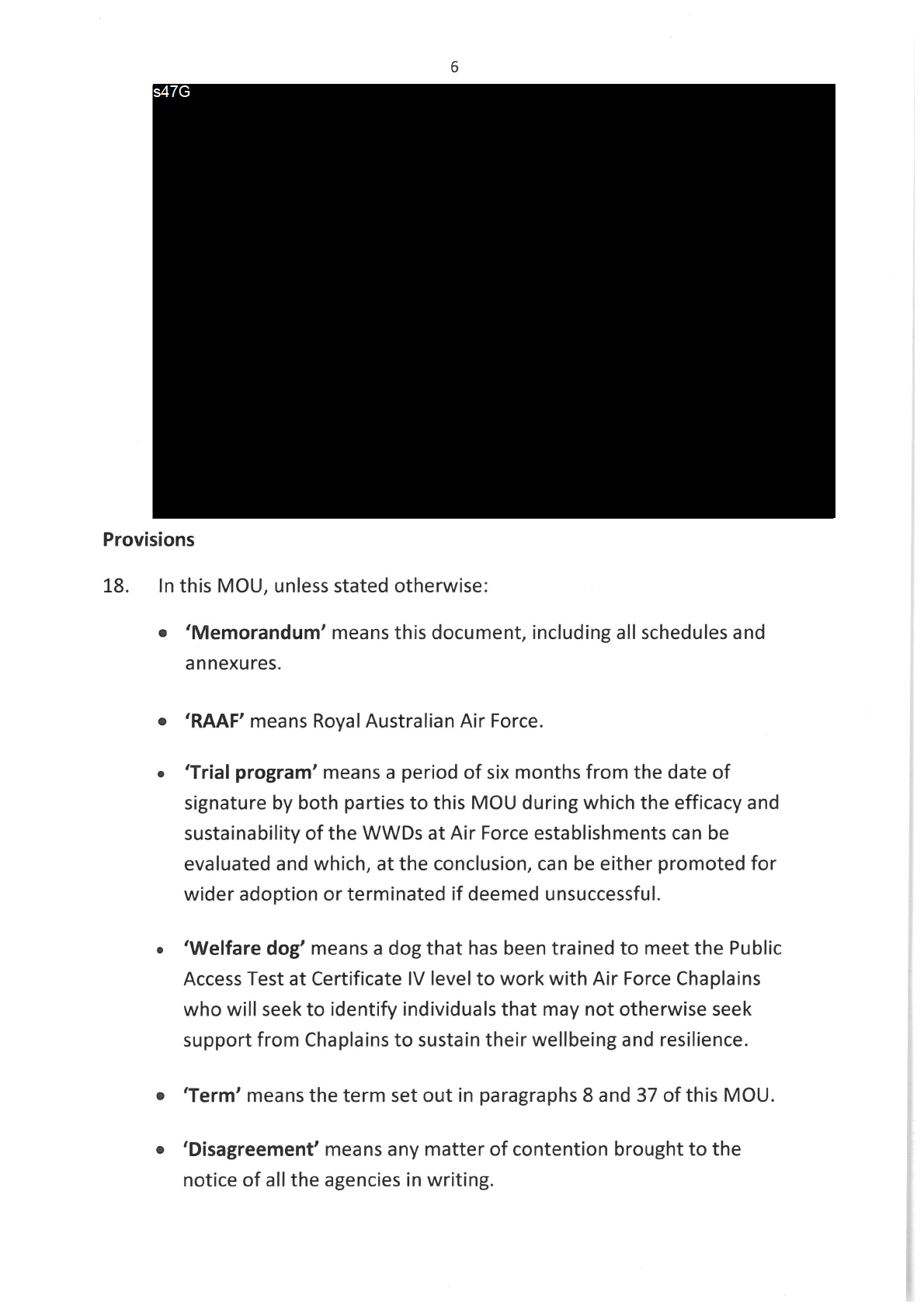
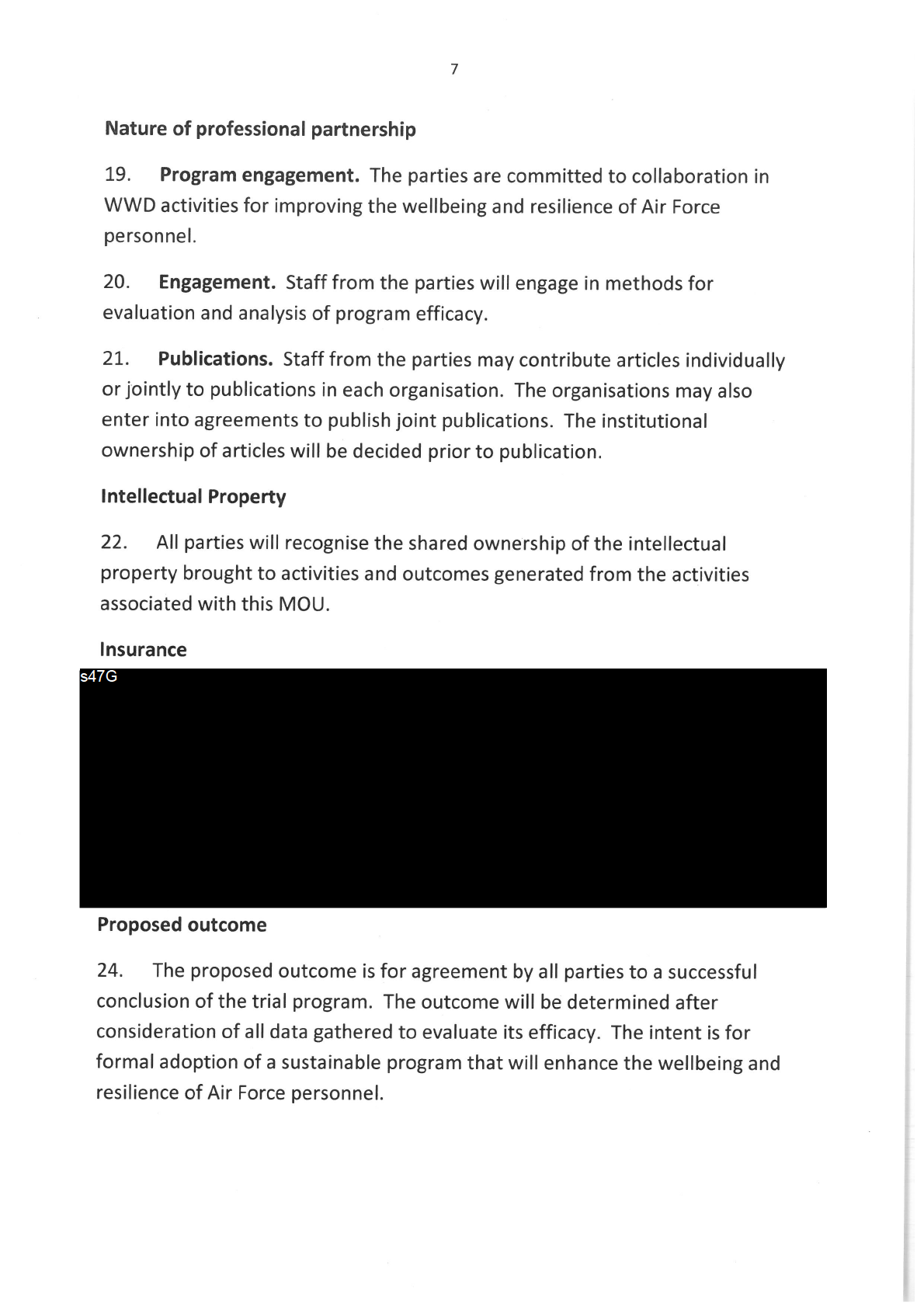
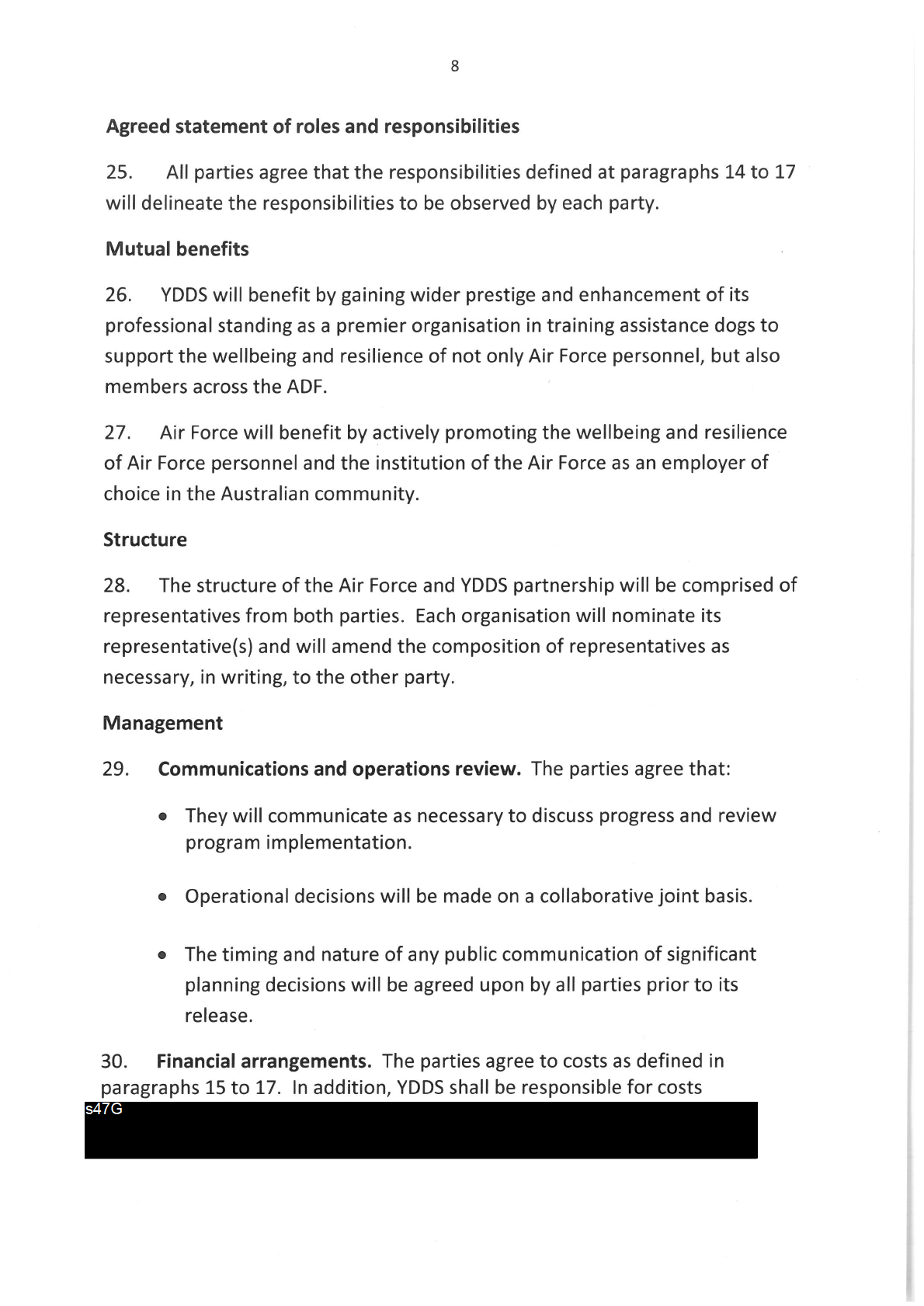
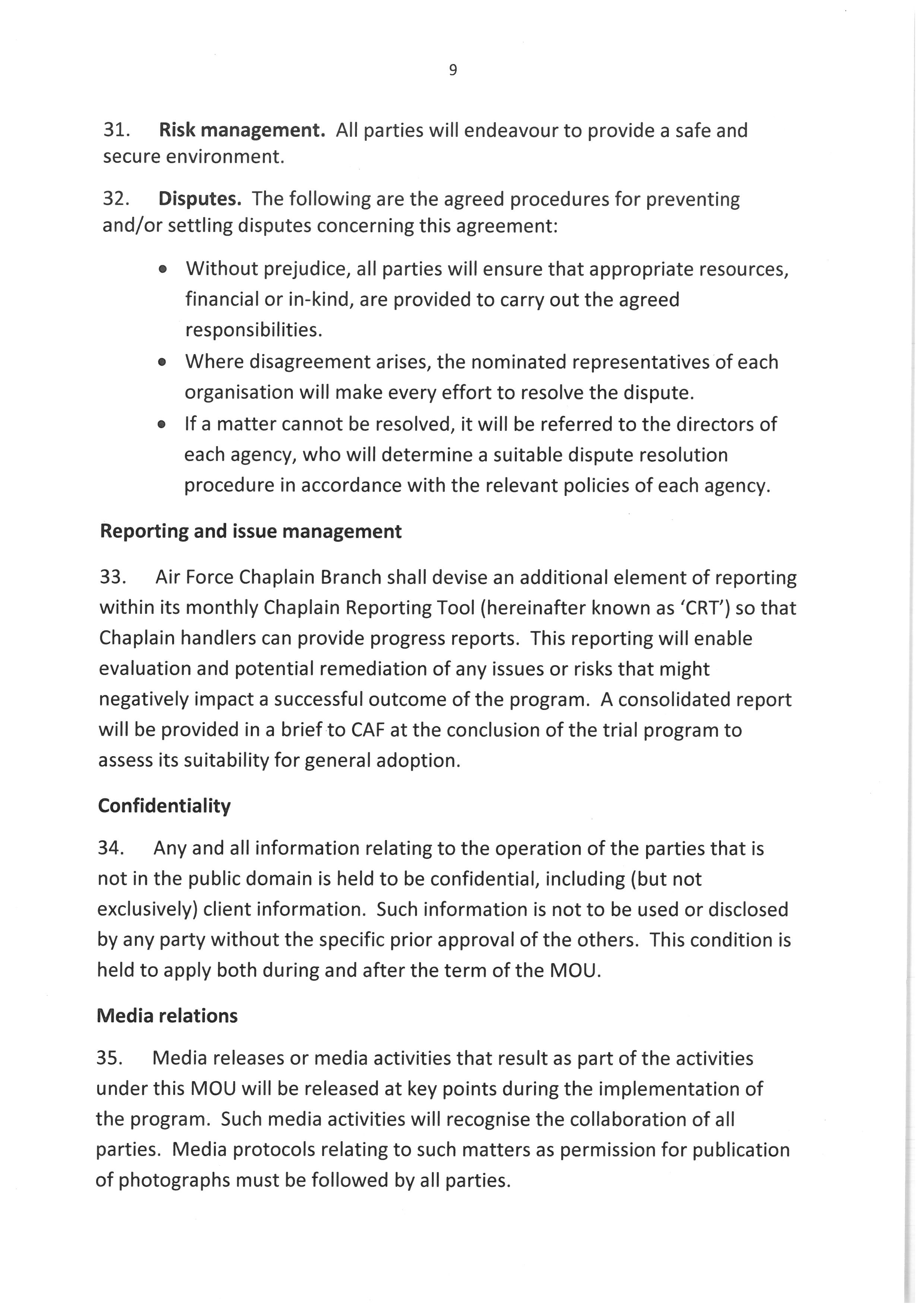
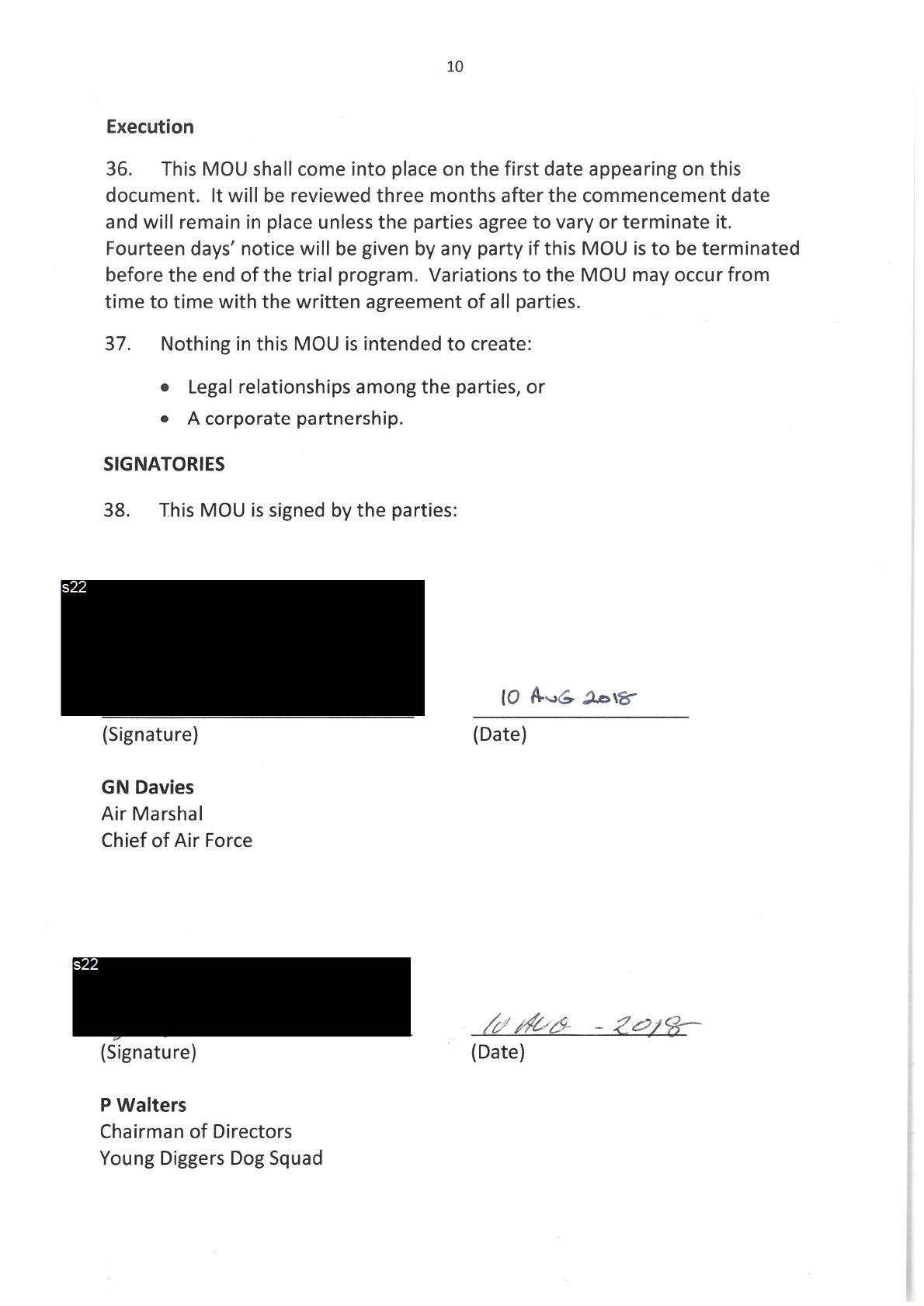
Pets prove to be a positive influence on social capital
Have you ever thought of pets as a uniting force encouraging cooperation, compromise and a general feeling of
reciprocity? This sounds like a grandiose concept, but is a little more plausible when you see dog owners
congregating at a dog park. Research shows that pets, and dogs in particular, can in fact bring people and
communities together.
What I am referring to is ‘social capital’, a complex concept defined simply as social relationships/interactions that
foster collective beneficial outcomes. Social capital has been shown to be beneficial in a range of social,
economic and political spheres, from social integration, cohesion and general societal wellbeing, to the efficient
running of modern economies and growth in gross domestic product (GDP), through to public health and
community governance.1
In a study spanning four cities in two continents, researchers from The University of Western Australia have
found that pet ownership contributes significantly to social capital.2 Individuals from comparable communities in
Perth (Australia), and Portland, Nashville and San Diego (USA) were surveyed on a number of social capital
determinants, including general helpfulness, friendliness, trust, reciprocity and civic engagement of people in their
community. The results showed that people with pets had more social capital than those without. Those with
dogs had even greater social capital and those who walked their dogs had even
more still (Diagram 1).
The authors suggest that their results reflect the idea that people with pets are deemed more trustworthy. And
trust is a key driver of social capital. Previous observational studies have also shown that people with pets
perceive others as more trustworthy.2
Physiologically, these perceptions could be the result of oxytocin production, which is known to increase feelings
of trust. Dog owners experience increased levels of oxytocin when interacting with their pooches and the authors
conject that the same response occurs when interacting with any companion animal (Diagram 2).
The positive effect of companion animals in other facets of human life has also been explored, with studies
showing pets can help individuals with mental illness3 and autism4, and can also help develop social skills, self-
esteem and curb loneliness in children.5
Collectively, this bank of research builds a strong case for more pet-friendly cities and societies. Given the
growing trend towards high-density apartment living in Australia, now is the time for town planners and
governments to develop strategies and policies to ensure our pets remain an integral part of our lives.
Nidhi Sodhi
Science Writer
References
1. Claridge T. Benefits and importance of social capital.
www.socialcapitalresearch.com/literature/theory/benefits.html. Accessed 2 August 2017.
2. Wood L, Martin K, Christian H et al. Social capital and pet ownership: a tale of four cities.
SSM Population
Health 2017;3:442–447.
3. Brooks H, Rushton L, Walker S et al. Ontological security and connectivity provided by pets: a study in the self-
management of the everyday lives of people diagnosed with a long-term mental health condition.
BMC
Psychiatry 2016;16:409.
4. O'Haire ME, McKenzie SJ, Beck AM et al. Animals may act as social buffers: skin conductance arousal in
children with autism spectrum disorder in a social context.
Dev Psychobiol 2015;57:584–595.
5. Purewal R, Christley R, Kordas K et al. Companion animals and child/adolescent development: a systematic
review of the evidence.
Int J Environ Res Public Health 2017;14:234.
